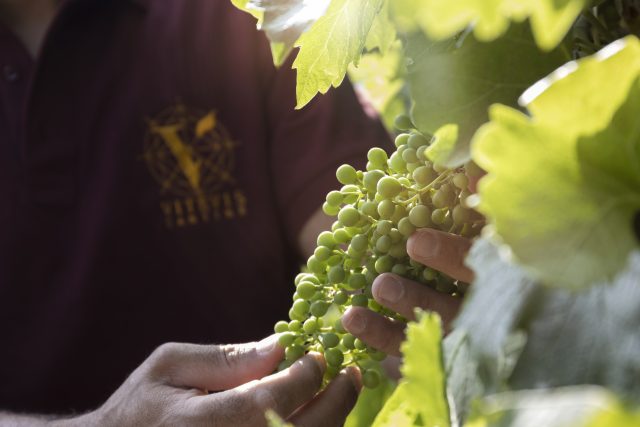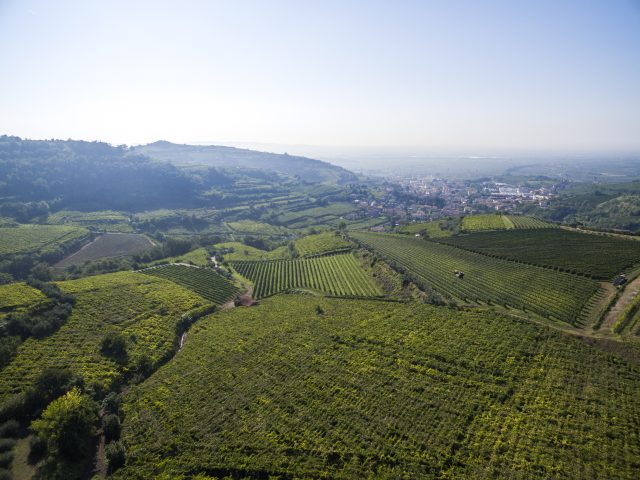This website uses cookies so that we can provide you with the best user experience possible. Cookie information is stored in your browser and performs functions such as recognising you when you return to our website and helping our team to understand which sections of the website you find most interesting and useful.
How Vitevis is pioneering sustainable winemaking in Veneto
Vitevis, one of Delle Venezie DOC’s leading co-operatives, has gone above and beyond to secure the long-term future of its Pinot Grigio production.

The statistics concerning the size of Vitevis’ operation are certainly impressive: 2,800 hectares of vineyards, 50,000 tonnes of grapes pressed each year, four wineries, three bottling lines, 13,000,000 bottles produced each year, 1,000 tank trucks, plus, not forgetting 1,350 winegrowers and around 90 other employees.
The company has four wineries in Veneto: Cantina Valleogra (near Malo, in the north), Cantina Colli Vicenti (near Montecchio Maggiore, towards the east), Cantina di Gambellara (near Gambellara, in the south), and Cantina di Castelnuovo del Garda (close to the shore of Lake Garda).
But, despite its scale, Vitevis has taken a number of measures to ensure that its environmental impact is a positive one, and guarantee the long-term sustainability and viability of its winemaking.
Cantine Vitevis export manager Valeria Quagiotto explained to db at this year’s London Wine Fair: “In 2017, we became the second co-operative to become an accredited company authorised by the Agriculture Ministry for the self-checking of the SQNPI (Sistema Qualità Nazionale di Produzione Integrata) protocol – and this means guaranteeing the reduction of usage of manmade chemicals, and reduce our impact on the territory.”
At present, 1,400ha, about half of Vitevis’ vineyard area, and 202 members are SQNPI certified.
SQNPI is not the only sustainability accreditation that Vitevis has gained. In April last year, it obtained the EQUALITAS standard, joining a select group of 70 Italian wineries to have received this recognition.
90 winegrower members of Vitevis, overseeing around 700ha, also joined the Agatheia start-up’s ‘NoiComepensiAmo’ project, which monitors greenhouse gas emissions with the aim of achieving carbon neutrality. Over three years, the project over-delivered on its aims, removing some 4,719 tonnes of Carbon dioxide from the atmosphere.
This attitude is continued in the wineries. In 2021, Vitevis adopted an ‘Energy Diagnosis’ tool to assess where and how it could cut its electricity usage. As a result of the assessment, new, more efficient refrigeration units were installed at Cantina di Castelnuovo del Garda, electric company cars were provided, and photovoltaic systems were installed to convert energy from the sun into electricity. Indeed, between 2021 and 2023, the amount of electricity provided through these solar panels has almost quadrupled to 1,127,045 KWh/year.

Knowledge of the land has been indispensable to Vitevis’ efforts.
Since 2013, Vitevis members with more than 1ha of land have been obliged to fill in an electronic treatment register that tracks what treatments are being used in the vineyard, and assesses their sustainability.
Natural solutions are heavily-utilised by the co-operative.
“For example,” Quagiotto explained, “last year we had problems with drought in Northern Italy. But thanks to specific practices in the vineyards provided by SQNPI Protocol, we have been able to prevent the losses.”
But, given the extent of the vineyard area, modern technology must also play a role.
The 4.0 Precision Agriculture Pinot Grigio project is focused on stabilising the yields and quality of Pinot Grigio specifically, while having minimal impact on the growing environment.
Satellite imagery provides up-to-date information on the state of the vineyards, taking Vitevis’ commitment to optimising its operation, quite literally, to new heights.
Quagiotto said: “We have a team of agronomists that check the satellite pictures once a week that we receive from Sentinel-2, and they cross the information with the weather columns, and the image shows exactly where to give water, where to give fertiliser, meaning that no resources get wasted.”
In 2021, when it launched, 12 winegrowers became involved. The following year, 42 participated.
As successful as this has been, along with the numerous other initiatives Vitevis participates in, Quagiotto shared that there is no slowing down: “This is a pilot project for the Pinot Grigio, and afterwards we will use this model for other grape varieties we cultivate.”

